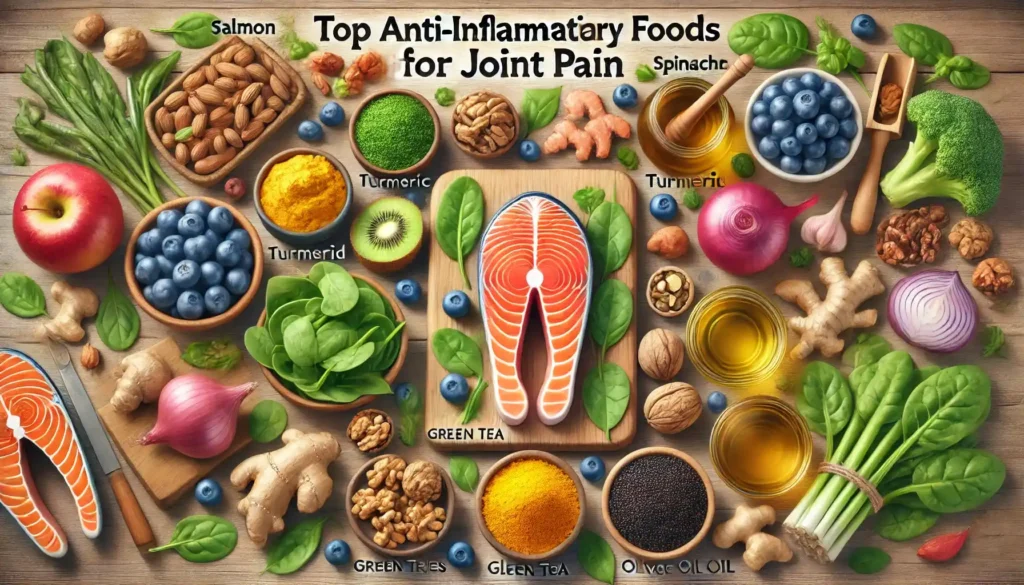Do your knees ache when you wake up? Or do your hands feel stiff after a long day? Joint pain is common, especially as we age. But, there’s a way to ease the pain without just using medicine. Your plate can be your secret weapon against joint pain. Here you can discover Top Anti-Inflammatory Foods for Joint Pain that help you improve your joints health.
Understanding Inflammation
Inflammation is your body’s natural response to injury or infection. While it helps you heal, chronic inflammation can cause problems like arthritis.
Chronic inflammation damages joint tissues. This leads to pain, swelling, and stiffness.
Certain foods can either fuel or fight inflammation. Choosing the best foods for joint health can help your joints.

The Power of Anti-Inflammatory Foods
Nutrients That Reduce Inflammation
- Omega-3 fatty acids: Found in fish and seeds.
- Antioxidants: Present in berries and greens.
- Polyphenols: Found in olive oil and tea.
Foods Rich in Anti-Inflammatory Properties
- Fruits and vegetables.
- Whole grains.
- Healthy fats.
Related: How Gut Health Impacts Joint Inflammation: Foods, Probiotics, and Tips to Reduce Pain
Top Anti-Inflammatory Foods for Joint Pain
Food with anti inflammatory properties and Their Benefits
| Food | Key Nutrients | Benefits for Joint Health |
|---|---|---|
| Fatty Fish | Omega-3 fatty acids | Reduces joint stiffness and swelling |
| Berries | Antioxidants, Vitamin C | Fights oxidative stress and reduces inflammation |
| Citrus Fruits | Vitamin C | Supports collagen production and reduces inflammation |
| Leafy Greens | Vitamins A, C, K | Protects joints and reduces oxidative damage |
| Nuts and Seeds | Omega-3s, Healthy Fats | Reduces inflammation and supports joint flexibility |
| Turmeric | Curcumin | Potent anti-inflammatory compound |
| Ginger | Gingerol | Reduces pain and stiffness in joints |
| Olive Oil | Polyphenols, Healthy Fats | Reduces inflammation and improves overall joint health |
| Whole Grains | Fiber | Lowers CRP (C-reactive protein), a marker of inflammation |
1. Fatty Fish
Fatty fish like salmon and tuna are full of omega-3 fatty acids. These are known for their anti-inflammatory effects.
- How it helps: Omega-3s reduce the production of inflammatory molecules.
- Pro tip: Eat at least two servings of fatty fish a week. If you don’t like fish, try a high-quality fish oil supplement.
2. Berries
Blueberries and raspberries are full of antioxidants and vitamin C.
- How it helps: Berries’ antioxidants fight free radicals that can cause inflammation.
- Pro tip: Add berries to your cereal, yogurt, or smoothies for a tasty anti-inflammatory boost.
3. Citrus Fruits
Oranges and lemons are rich in vitamin C.
- How it helps: Vitamin C supports collagen production and has anti-inflammatory properties.
- Pro tip: Enjoy a glass of orange juice or add citrus slices to your water for a refreshing drink.
4. Leafy Greens
Spinach and kale are nutritional powerhouses.
- How it helps: These greens are full of vitamins A, C, and K, and fiber, which fights inflammation.
- Pro tip: Steam your greens lightly or add them raw to salads.
5. Nuts and Seeds
Walnuts and chia seeds are full of healthy fats and omega-3s.
- How it helps: These foods lower inflammation markers and improve joint flexibility.
- Pro tip: Snack on nuts or sprinkle seeds on your oatmeal or salads for crunch.
6. Turmeric
Turmeric is a yellow spice used in Indian cuisine.
- How it helps: Turmeric’s curcumin reduces joint pain and swelling in arthritis patients.
- Pro tip: Mix turmeric with black pepper to boost curcumin absorption. Use it in teas, soups, or curries.
7. Ginger
Ginger is a flavorful spice and a strong anti-inflammatory remedy.
- How it helps: Gingerol, its active compound, blocks the production of pro-inflammatory substances in the body.
- Pro tip: Brew fresh ginger tea or add grated ginger to stir-fries and smoothies.
8. Olive Oil
Extra virgin olive oil is a key part of the Mediterranean diet. It’s full of healthy fats.
- How it helps: Olive oil contains polyphenols and oleocanthal, which mimic the effects of anti-inflammatory medications.
- Pro tip: Use olive oil as your primary cooking oil or drizzle it over salads and roasted vegetables.
9. Whole Grains
Whole grains like quinoa, brown rice, and oats are high in fiber.
- How it helps: Fiber helps lower inflammation by reducing CRP levels in the blood.
- Pro tip: Swap refined grains with whole grains in your meals to enjoy sustained energy and joint health foods benefits.
Adding these anti-inflammatory foods to your diet can help reduce joint pain and improve health. Remember, consistency is key!
Building an Anti-Inflammatory Meal Plan
Creating a structured meal plan can make it easier to incorporate anti-inflammatory foods into your daily routine. Here’s how you can build a balanced, anti-inflammatory diet to reduce joint pain and improve overall health.

Sample One-Day Anti-Inflammatory Meal Plan
| Meal | Menu | Key Nutrients | Benefits for Joint Health |
|---|---|---|---|
| Breakfast | Oatmeal topped with blueberries and chia seeds | Fiber, antioxidants, omega-3s | Reduces inflammation, provides sustained energy |
| Mid-Morning Snack | A handful of walnuts and a fresh orange | Omega-3s, vitamin C | Anti-inflammatory fats, collagen support |
| Lunch | Grilled salmon with a spinach salad dressed in olive oil | Omega-3s, vitamins A, C, healthy fats | Reduces joint stiffness, anti-inflammatory |
| Afternoon Snack | Greek yogurt with a sprinkle of flaxseeds | Protein, omega-3s | Supports muscle and joint health |
| Dinner | Stir-fried broccoli and quinoa with turmeric-roasted chicken | Fiber, vitamins, curcumin, protein | Combats inflammation, supports joint repair |
| Evening Snack | Herbal ginger tea | Anti-inflammatory spices | Reduces joint pain, promotes relaxation |
1. Sample One-Day Meal Plan
Creating a meal plan helps ensure you get the right mix of food with anti inflammatory properties all day. Here’s a sample one-day meal plan:
Breakfast: Oatmeal with Blueberries and Chia Seeds
Start with a hearty bowl of oatmeal, topped with fresh blueberries and a tablespoon of chia seeds.
- Nutrients: Fiber from oatmeal, antioxidants from blueberries, omega-3s from chia seeds.
- Benefits: This mix reduces inflammation and keeps you full longer.
Mid-Morning Snack: Walnuts and a Fresh Orange
Enjoy a handful of walnuts with a juicy orange.
- Nutrients: Omega-3 fatty acids from walnuts, vitamin C from oranges.
- Benefits: Supports collagen production and provides anti-inflammatory fats.
Lunch: Grilled Salmon with Spinach Salad
Grilled salmon over fresh spinach, drizzled with extra virgin olive oil.
- Nutrients: Omega-3s from salmon, vitamins A and C from spinach, healthy fats from olive oil.
- Benefits: Reduces joint stiffness and combats inflammation effectively.
Afternoon Snack: Greek Yogurt with Flaxseeds
A bowl of Greek yogurt with ground flaxseeds.
- Nutrients: Protein from yogurt, omega-3s from flaxseeds.
- Benefits: Supports muscle and joint health while providing anti-inflammatory benefits.
Dinner: Turmeric-Roasted Chicken with Stir-Fried Broccoli and Quinoa
Tender chicken roasted with turmeric, served with stir-fried broccoli and quinoa.
- Nutrients: Curcumin from turmeric, fiber from quinoa, vitamins from broccoli, protein from chicken.
- Benefits: Combats inflammation and supports joint repair and overall health.
Evening Snack: Herbal Ginger Tea
A warm cup of ginger-infused herbal tea.
- Nutrients: Gingerol from ginger.
- Benefits: Reduces joint pain and promotes relaxation before bedtime.
2. Tips for Incorporating Anti-Inflammatory Foods
Adding anti-inflammatory foods to your diet is easy. Here are some tips to make it simple:
Plan Your Meals Ahead
- Why: Planning helps you have the right ingredients and avoids unhealthy choices.
- How: Set aside a day each week for meal prep. Cook grains, chop veggies, and portion snacks.
Choose Whole Foods Over Processed Ones
- Why: Whole foods keep more nutrients and don’t have additives that cause inflammation.
- How: Focus on fresh fruits, veggies, whole grains, and lean proteins. Check labels to avoid hidden sugars and unhealthy fats.
Incorporate Healthy Fats
- Why: Healthy fats like olive oil, nuts, and fatty fish are key for reducing inflammation.
- How: Use olive oil for cooking, add nuts and seeds to salads, and include fatty fish in your meals.
Add a Splash of Anti-Inflammatory Spices
- Why: Spices like turmeric and ginger add flavor and have strong anti-inflammatory effects.
- How: Sprinkle turmeric on roasted veggies, add ginger to smoothies, or make a turmeric latte.
Stay Hydrated
- Why: Drinking enough water helps keep joints lubricated and supports overall health.
- How: Drink at least 8 glasses of water a day. Add citrus slices or herbs to your water for taste.
Balance Your Plate
- Why: A balanced plate gives you the nutrients your joints need.
- How: Eat half your plate with veggies, a quarter with lean protein, and a quarter with whole grains. Add healthy fats as needed.
Experiment with New Recipes
- Why: Trying new recipes keeps your diet interesting and ensures you get a variety of nutrients.
- How: Look for anti-inflammatory cookbooks or online recipes. Try different cuisines that use fresh ingredients and healthy fats.
Mindful Eating
- Why: Mindful eating helps you enjoy your food and know when you’re full, preventing overeating.
- How: Eat slowly, savor each bite, and listen to your body’s hunger and fullness signals.
Natural Remedies for Joint Pain

Hydration and Its Role in Joint Health
Staying hydrated helps maintain the elasticity of cartilage, reducing joint friction.
- How to stay hydrated: Drink at least 8 glasses of water daily. Incorporate herbal teas and water-rich foods like cucumbers and watermelon.
Physical Activity and Inflammation
Exercise keeps joints flexible and reduces inflammation over time.
- Recommended activities: Low-impact exercises like swimming, cycling, and yoga can strengthen muscles around the joints without causing strain.
Related: Natural Remedies for Joint Pain
Weight Management as a Natural Remedy
Carrying less weight reduces strain on your joints, lowering inflammation levels.
- Tips for weight management: Combine a balanced diet with regular physical activity. Consult with a healthcare professional for personalized advice.
Conclusion
Your journey to easing joint pain starts with the food on your plate. By incorporating anti-inflammatory foods and avoiding the bad guys, you can take control of your joint health naturally. Start small, and before you know it, you’ll feel the difference in your joints and overall well-being.